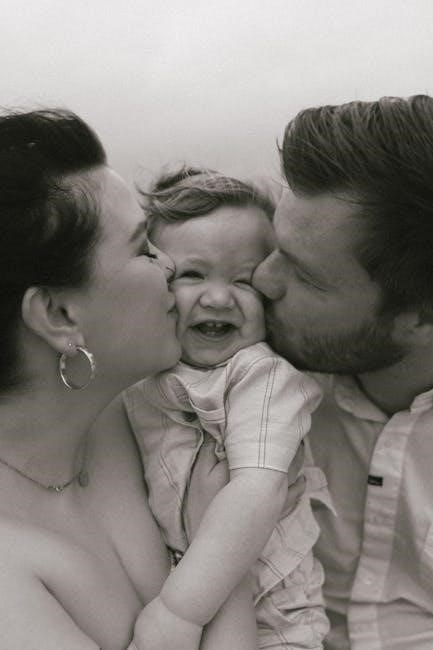This section introduces the 2013 horror film Mama, directed by Andy Muschietti, starring Jessica Chastain․ It explores the story of two girls raised by a mysterious spirit, providing a parent guide to help families decide if it’s suitable for children, focusing on horror elements and themes․
1․1 About the Movie “Mama”
Mama is a 2013 supernatural horror film directed by Andy Muschietti, based on his 2008 short film Mamá․ The movie follows two young girls, Victoria and Lily, who are abandoned in a remote cabin after their father’s tragic death․ The girls are mysteriously cared for by a supernatural entity they call “Mama,” a vengeful spirit with a deep, albeit unsettling, maternal instinct․ Five years later, the girls are discovered by their uncle, Lucas, and his girlfriend, Annabel, who take them in to rebuild their lives․ However, Mama follows, leading to a series of eerie and terrifying events․ The film explores themes of motherhood, loss, and the supernatural, blending horror with emotional drama․ Starring Jessica Chastain, Nikolaj Coster-Waldau, and Megan Charpentier, Mama has become a modern horror classic, praised for its atmospheric tension and compelling storytelling․ The movie is rated PG-13 for violence, terror, and thematic elements, making it a thought-provoking yet unsettling watch․

1․2 Purpose of the Parent Guide
The Mama Parents Guide is designed to help parents make informed decisions about whether the film is suitable for their children․ It provides a detailed overview of the movie’s content, including horror elements, violence, language, and mature themes․ The guide examines the film’s rating, specific scenes, and overall tone to assist parents in assessing its appropriateness for different ages․ It also offers insights into the emotional and psychological aspects of the story, such as themes of grief, loss, and trauma, which may require post-viewing discussions․ Additionally, the guide highlights the importance of considering a child’s sensitivity and maturity level when deciding to watch Mama․ By offering clear and concise information, the guide empowers parents to create a safe and thoughtful viewing experience for their families, ensuring they are prepared to address any questions or concerns that may arise from the film’s content․

Content Overview
This section provides a brief overview of the films content, highlighting its horror elements, supernatural themes, and suspenseful plot․ It sets the stage for analyzing the movies suitability for younger audiences․
2․1 Horror Elements in “Mama”
Mama is a supernatural horror film filled with eerie and terrifying elements designed to unsettle viewers․ The ghostly figure of Mama, with her unsettling movements and appearance, is central to the films scares․ Her ability to float like a wraith and move like a spider creates a chilling presence․ The movie features nightmarish scenes, such as a child eating bugs and disturbing imagery of Mama’s supernatural form․ The films atmosphere is heightened by creepy settings like the isolated cabin in the woods, adding to the sense of dread․ Jumpscares and intense moments of suspense are strategically placed to keep audiences on edge․ While the film avoids excessive gore, the horror is more psychological, focusing on fear of the unknown and the supernatural․ The use of sound and visuals plays a significant role in building tension, making the horror elements impactful․ Parents should be cautious, as these elements may be too intense for younger or more sensitive viewers, despite the PG-13 rating․
2․2 Supernatural Themes and Suspense
Mama masterfully blends supernatural themes with suspense to create a captivating and unsettling narrative․ The films central plot revolves around the mysterious entity Mama, a ghostly figure who becomes the caregiver of two abandoned girls․ This supernatural element is woven into a web of suspense, as the audience is kept guessing about Mamas true nature and intentions․ The movies tension is heightened through its use of eerie environments, such as the isolated cabin, and the gradual revelation of Mamas presence․ The suspense is further amplified by the films pacing, which builds slowly, allowing the audience to absorb the creepy atmosphere․ Themes of motherhood and protection are intertwined with the supernatural, adding depth to the horror․ The films ability to balance suspense with emotional storytelling makes it both thrilling and thought-provoking․ Parents should be aware that these supernatural themes and suspenseful moments may be too intense for younger viewers, even though the film is rated PG-13․
2․3 Key Scenes and Plot Points
The film Mama unfolds with several pivotal scenes that drive its haunting narrative․ The story begins with two young girls, Victoria and Lily, being abandoned in a remote cabin after their father’s tragic death․ Five years later, they are discovered, and their uncle, Lucas, and his girlfriend, Annabel, take them in․ However, the girls are accompanied by a mysterious entity, Mama, who has been their caregiver in the woods․ Key scenes include the girls’ adjustment to their new home, where strange occurrences hint at Mamas presence․ Tensions rise as Mama’s influence becomes more pronounced, leading to frightening confrontations․ A climactic scene reveals Mamas tragic backstory and her relentless desire to protect the girls, even at a terrible cost․ These plot points are central to the films horror elements and emotional depth, making them essential for understanding the movies themes and content, which are critical for parents evaluating its suitability for children․

Content Breakdown
This section breaks down the movie’s content, including violence, gore, mild sex, and profanity, with a focus on frightening scenes and supernatural elements that contribute to its PG-13 rating․
3․1 Violence and Gore
The movie Mama contains moderate violence and some disturbing imagery, though it avoids excessive gore․ Scenes include a man murdering his partners, a woman stabbed, and children in peril․ These elements contribute to its PG-13 rating and may unsettle sensitive viewers․
3․2 Sex and Nudity
Mama features mild sexual content, including a scene where a man and a woman kiss and discuss going to his apartment, implying sex without explicit depiction․ Brief suggestions of intimacy occur, but no nudity is shown․ The focus remains on the horror and supernatural elements rather than explicit sexual content․ While the movie avoids graphic sexual scenes, parents should be aware of these subtle moments when deciding suitability for younger viewers․
3․3 Profanity and Language
The movie Mama contains moderate profanity, including occasional use of strong language such as the F-word, sexual references, and scatological terms․ While not overly pervasive, these elements are present enough to warrant consideration for younger audiences․ The film’s PG-13 rating reflects this, as it includes language that may not be suitable for all children․ Parents should be aware of these moments, as they could require discussion or context for impressionable viewers․ The profanity is not excessive but contributes to the film’s mature tone․ While the horror and supernatural elements are the primary focus, the language adds to the overall intensity of the story․ It’s essential for parents to assess their child’s sensitivity to such content before allowing them to watch․ The movie balances its scares with emotional depth, but the language remains a key factor in determining its appropriateness for younger viewers;
3․4 Frightening and Intense Scenes
Mama is a horror film filled with numerous frightening and intense scenes designed to unsettle viewers․ The supernatural entity, Mama, is a central source of fear, with her unsettling appearance and movements․ Scenes featuring her manifestation, such as floating like a wraith or moving like a spider, are particularly terrifying․ The film also includes moments of psychological horror, such as the girls’ disturbing behavior influenced by Mama, and the eerie atmosphere of the isolated cabin․ Intense sequences involve children in peril, including a child eating bugs, which adds to the unease․ The combination of jump scares, creepy visuals, and a haunting soundtrack amplifies the tension, making the movie unsuitable for younger or more sensitive audiences․ Parents should carefully consider their child’s ability to handle such intense frights before allowing them to watch․ The film’s ability to blend emotional drama with horror ensures a memorable but potentially distressing experience for some viewers․

Themes and Messages
Mama explores themes of motherhood, loss, and family dynamics․ It delves into the power of love and parenting, highlighting the unbreakable bond between a mother and child, even in death․ The film also examines grief, trauma, and the challenges of found family, offering a poignant yet terrifying narrative that resonates emotionally with audiences․
4․1 Motherhood and Parenting
Mama delves deeply into the theme of motherhood, exploring the lengths to which a mother will go to protect and nurture her children․ The titular character, a supernatural entity, embodies an extreme form of maternal instinct, driven by a desire to care for the two girls, Victoria and Lily․ Her unconventional and often terrifying methods of parenting highlight the complexities of motherhood, where love and protection can manifest in ways that are both fierce and unsettling․ The film contrasts this supernatural motherhood with the human parents, Lucas and Annabel, who struggle to balance their own lives with the responsibilities of caring for the girls․ This contrast underscores the challenges of parenting and the sacrifices it demands․ The movie ultimately portrays motherhood as a powerful, multifaceted force that transcends conventional boundaries, blending horror and drama to create a compelling exploration of maternal love․
4․2 Loss, Grief, and Trauma
The film Mama explores themes of loss, grief, and trauma through its haunting narrative․ The story begins with a tragic event: the death of the girls’ parents, leaving Victoria and Lily emotionally scarred․ Their isolation in the cabin intensifies their trauma, as they are forced to rely on the supernatural entity, Mama, for survival․ The film portrays the psychological impact of abandonment and the struggle to cope with loss․ Mama’s relentless presence symbolizes the enduring power of grief, as she refuses to let go of the girls, even as they attempt to rebuild their lives with Lucas and Annabel․ The characters’ emotional journeys reveal the long-lasting effects of trauma, particularly on children, and how it shapes their perceptions of love and family․ The film’s depiction of grief is both unsettling and poignant, highlighting the fragility of the human psyche in the face of overwhelming loss․ This theme serves as a foundation for the film’s horror elements, making it a deeply emotional and psychological experience․

4․3 Family Dynamics and Relationships
The film Mama examines the complex dynamics within families, particularly the relationships between parents and children․ Lucas and Annabel, though initially reluctant, take on the role of caregivers for Victoria and Lily, showcasing the challenges of blending unconventional family structures․ The girls’ bond with each other, forged during their isolation, is central to the story, highlighting the strength of sibling ties․ Mama, as a supernatural maternal figure, represents a twisted version of motherhood, driven by possessive love․ The film contrasts this with Annabel’s growing maternal instincts, creating tension between natural and unnatural forms of care․ Family dynamics are further explored through the characters’ struggles to balance love, responsibility, and fear․ The movie illustrates how relationships can both heal and harm, emphasizing the importance of human connection in overcoming trauma․ These themes resonate with audiences, offering a poignant reflection on the complexities of family life․

Parental Guidance
Mama is rated PG-13 for violence and terror․ Parents should use discretion, especially for sensitive children, due to intense scenes and themes of grief․ Guiding discussions can help children process the film’s emotional depth․
5․1 Age Recommendations
Mama is rated PG-13 by the MPAA for violence, terror, and thematic elements․ The film is generally suitable for viewers aged 13 and above due to its horror elements and mature themes․ However, parental discretion is advised, as younger or more sensitive children may find the supernatural scenes and intense moments unsettling․ The movie’s content includes frightening imagery, such as the ghostly figure of Mama, and deals with themes of loss and grief, which may require guidance for younger audiences․ Older teenagers are likely to handle the scares and emotional depth better, but parents should still assess their child’s maturity level before allowing them to watch․ The film’s complexity and horror elements make it less appropriate for children under 13, emphasizing the need for careful consideration by parents or guardians․
5․2 Sensitivity and Maturity Considerations
Mama contains elements that may affect children differently based on their sensitivity and maturity․ The film’s supernatural themes, eerie atmosphere, and frightening scenes, such as the ghostly apparition of Mama and her unsettling movements, can be deeply unsettling for younger or more sensitive viewers․ While the movie is rated PG-13, its emotional depth and horror elements require careful consideration․ Themes of loss, grief, and trauma are central to the story and may resonate strongly with children who have experienced similar emotions, potentially evoking distress․ Additionally, the film’s portrayal of a spirit’s possessive and protective nature could be confusing or alarming for younger audiences․ Parents should assess their child’s ability to distinguish fantasy from reality and handle intense emotional and supernatural content․ Open discussions about the film’s themes can help children process its scarier moments and deeper meanings, making it a valuable but potentially challenging watch for sensitive viewers․ Parental guidance is strongly recommended to ensure a positive viewing experience․
5․3 Tips for Watching with Children
Watching Mama with children requires careful preparation to ensure a positive experience․ Parents should first preview the film to assess its suitability for their child’s sensitivity level․ Creating a safe viewing environment, such as watching together in a well-lit room, can help children feel more secure․ Encouraging open dialogue during and after the movie allows kids to express their feelings and questions․ Discussing the movie’s themes, such as the concept of Mama as a supernatural caregiver, can help children differentiate between fantasy and reality․ Parents should also be prepared to address any fears or misunderstandings that arise․ For younger or more sensitive children, it may be wise to watch the film in shorter segments, allowing time to process the content․ Ultimately, being present and reassuring during the viewing experience can help children navigate the film’s intense moments and foster a deeper understanding of its story and themes․ This approach ensures a thoughtful and guided exposure to the movie’s horror elements․

Making Informed Decisions
Assessing a child’s maturity and sensitivity is key when deciding to watch Mama․ The PG-13 rating and horror elements should guide parents in evaluating the film’s suitability for their child, ensuring a thoughtful decision․
6․1 Assessing Your Child’s Maturity
Evaluating your child’s readiness for Mama involves considering their emotional and psychological maturity․ The film’s horror elements, including unsettling visuals and intense scenes, can be deeply disturbing for younger or more sensitive children․ Parents should reflect on their child’s ability to distinguish between fantasy and reality, as the supernatural themes may provoke fear or anxiety․ Additionally, the movie’s exploration of loss and grief requires a certain level of emotional understanding․ It’s crucial to gauge whether your child can handle these themes without experiencing long-term distress․ Age alone isn’t the only factor; individual sensitivity and coping mechanisms play a significant role․ Open discussions about the film’s content can help parents determine if their child is prepared for the experience․ Ultimately, understanding your child’s maturity ensures a responsible and informed decision about their viewing of Mama․

6․2 Discussing the Movie’s Themes
Engaging in conversations about Mama’s themes is crucial for helping children process the film’s complex ideas․ The movie explores profound topics such as motherhood, loss, grief, and the supernatural, which can be challenging for young viewers to grasp․ Parents should guide discussions to ensure children understand the emotional depth of the story․ For instance, the character of Mama represents a distorted form of maternal love, which can spark conversations about healthy parenting and the consequences of unchecked grief․ Additionally, the film’s portrayal of trauma and its effects on the girls offers an opportunity to talk about resilience and healing․ Encouraging children to share their thoughts and feelings about these themes can help them develop empathy and critical thinking․ By fostering open dialogue, parents can transform the viewing experience into a meaningful lesson about love, family, and overcoming adversity․ This approach not only enhances understanding but also strengthens the bond between parent and child․
6․3 Setting Boundaries for Viewing
Establishing clear boundaries is essential when allowing children to watch Mama․ Parents should consider their child’s age, sensitivity, and maturity level before permitting viewing․ While the film is rated PG-13, its horror elements, intense scenes, and themes of loss and grief may be too unsettling for younger or more sensitive viewers․ Setting boundaries might include watching the film together to provide context and reassurance or limiting exposure to certain scenes․ Parents should also create a safe space for children to process their emotions post-viewing․ Encouraging open conversations about what they found frightening or confusing can help address any lingering fears․ Additionally, setting boundaries may involve restricting screen time or ensuring the child is emotionally prepared for the film’s content․ By doing so, parents can help their children navigate the movie’s darker themes while fostering a positive and supportive viewing experience․ This approach ensures that boundaries are respected and the child’s well-being is prioritized․
Mama is a thought-provoking horror film that balances scares with emotional depth․ This guide helps parents make informed decisions, ensuring a safe viewing experience for children while exploring themes of love, loss, and family․
7․1 Final Thoughts on “Mama”

Mama stands out as a compelling horror film that masterfully blends suspense with emotional depth․ Its exploration of motherhood, grief, and family dynamics adds complexity to the genre, making it more than just a scary movie․ While it contains intense and frightening scenes, the film’s intelligent storytelling and strong performances make it a standout in horror cinema․ Parents should carefully consider their child’s sensitivity before allowing them to watch, as the themes and imagery may be too mature for younger audiences․ However, for older teens and mature viewers, Mama offers a thought-provoking experience that sparks reflection on love, loss, and the unbreakable bonds of family․ With proper guidance, it can be a valuable and memorable watch, showcasing how horror can explore deep emotional truths․
7․2 The Movie’s Cultural Impact
Mama has left a lasting impact on the horror genre, praised for its unique storytelling and emotional depth․ Directed by Andy Muschietti, the film gained recognition for its ability to blend suspense with heartfelt themes, making it a standout in modern horror․ The movie’s exploration of motherhood and grief resonated with audiences, sparking conversations about the power of love and parenting․ Its success also highlighted the potential of international filmmakers in Hollywood, as Muschietti transitioned from Argentine cinema to global acclaim․ Produced by Guillermo del Toro, Mama further solidified its cultural relevance, drawing acclaim for its atmospheric visuals and chilling performances․ The film’s legacy lies in its ability to balance horror with poignant human drama, influencing subsequent horror films to explore deeper emotional narratives․ Its impact continues to be felt, making it a memorable and influential work in contemporary horror cinema․
7․3 Comparison with Other Horror Films
While Mama shares similarities with other horror films in its use of supernatural elements and suspense, its unique approach to storytelling sets it apart․ Unlike traditional horror movies that rely heavily on gore, Mama focuses on emotional depth and psychological tension․ The film’s portrayal of a maternal spirit driven by love and protection mirrors themes found in movies like The Others and Pan’s Labyrinth, but its execution feels fresher and more intimate․ The character of Mama, with her unsettling appearance and tragic backstory, is reminiscent of iconic horror villains yet feels distinctly original․ The movie’s ability to balance horror with heartfelt drama is a rare quality, making it a standout in the genre․ By blending atmospheric scares with a poignant exploration of motherhood, Mama offers a cinematic experience that resonates long after the credits roll, distinguishing it from more formulaic horror films․
